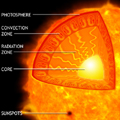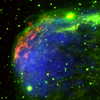Stars do not form in isolation, but in clusters which can have thousands of members. Because the stars in a cluster were all born at roughly the same time and are at roughly the same distance, a star cluster provides an ideal laboratory for testing theories of how the behavior of stars depends on their mass. Since most star clusters eventually disperse, we see them when the stars are relatively (less than a few hundred million years) young.
Clusters of young stars are irregularly shaped and are called open clusters, to distinguish them from globular clusters, spherically shaped clusters of stars. Besides looking different, the two types of clusters are different in other, fundamental ways:
- Open clusters are composed of very young stars with ages less than a few hundred million years, whereas stars in globular clusters are typically 10-12 billion years old.
- Open clusters typically tend to lie in the spiral arms of the Galaxy, whereas globular clusters are scattered in a roughly spherical distribution about the center of the Galaxy.
- Open clusters contain hundreds to thousands of stars, whereas globular clusters contain hundreds of thousands to a few million stars.
Protostars and very young stars are usually surrounded by disks of dust and gas. Some of this matter will fall onto the young star and may produce X-rays as the particles are accelerated by the gravity of the star and collide with the gas on its surface. In the young (age less than 10 million years) star TW Hydrae, the X-ray spectrum provides strong evidence for this process.
Much of the matter in the circumstellar disk will be blown away by intense radiation from the star, but some of it may form into planets. Chandra observations of the Orion Nebula cluster indicate that the X-radiation from the parent star may influence this process.
Stellar Nursery - Orion NebulaAt a distance of about 1800 light years, the Orion Nebula cluster is the closest large star-forming region to Earth. Chandra's image shows about a thousand X-ray emitting young stars in the Orion Nebula star cluster. The X-rays are produced in the hot, multimillion-degree upper atmospheres, or coronas, of these stars.
Although the X-ray luminosity of stellar coronas is a small fraction of the total stellar luminosity, it is an important indicator of the means of transporting energy outward from the nuclear power source in the central region of a star. In very young stars, the nuclear power source is just coming "on-line," and is relatively weak. One consequence of this is that the energy is transported outward by vigorous gas motions, called convection.
When combined with rotation, convection can produce a tangled magnetic field that heats the star's upper atmosphere or corona, sometimes explosively. For this reason, young stars are observed to be strongly variable coronal X-ray sources.
The rolling, boiling like convective motion in the outer layers of a star, coupled with the star's rotation, twists the magnetic field and increases its strength. Twisted, magnetized loops of hot gas rise high above the surface of the star, where they make up the corona - the outermost layers of the star's atmosphere. The unwinding of these twisted magnetic fields could heat gas trapped in these loops to X-ray emitting temperatures of millions of degrees by releasing the pent-up energy either gradually, or explosively in flares.
An in-depth survey of young (1-10 million years old) sun-like stars in the Orion Nebula Cluster have revealed that they produce violent X-ray outbursts, or flares, that are much more frequent and energetic than anything seen today from our 4.6 billion-year-old sun. The range of flare energies is large, with some of the stars producing flares that are a hundred times larger than others. The extent to which this flaring activity affects the formation of planets and the subsequent possibility of life evolving there is not well understood.
According to some theoretical models, large flares could produce strong turbulence in a planet-forming disk around a young star. Such turbulence might affect the position of rocky, Earth-like planets as they form and prevent them from rapidly migrating toward the young star. Therefore, the survival chances of the Earth may have been enhanced by large flares from the young sun.
Stellar Winds from Massive StarsWhile sun-like stars will shine for billions of years, massive stars lead short, spectacular lives. After only a few million years, a star that is a dozen or more times as massive as the sun will be using energy prodigiously and rushing headlong toward a supernova catastrophe. First, the massive star will expand enormously to become a red giant, and eject its outer layers at a speed of about 20,000 miles per hour. A few hundred thousand years later - a blink of the eye in the life of a sun-like star - the intense radiation from the exposed hot, inner layer of the massive star begins to push gas away at speeds in excess of 3 million miles per hour!
When this high speed "stellar wind" rams into the slower red giant wind, a dense shell is formed. The force of the collision creates two shock waves: one that moves outward, lighting up the dense shell, and one that moves inward to produce a bubble of million-degree Celsius X-ray emitting gas. Massive stars can lose half or more of their mass through stellar winds. The momentum from the radiation-driven winds creates large bubbles in surrounding clouds of dust and gas, which can trigger the formation of a new generation of stars. Observations of these hot bubbles by Chandra give new insight into an energetic phase in the evolution of massive stars.






